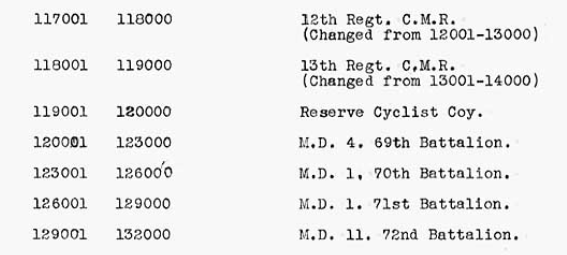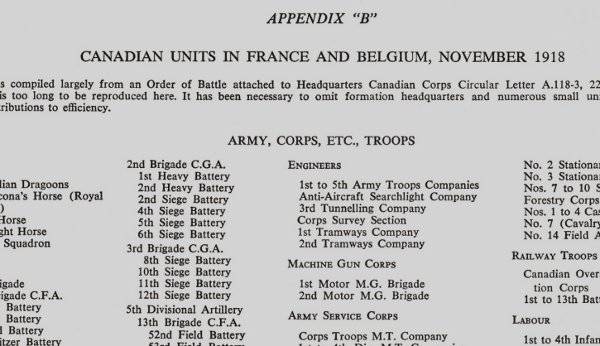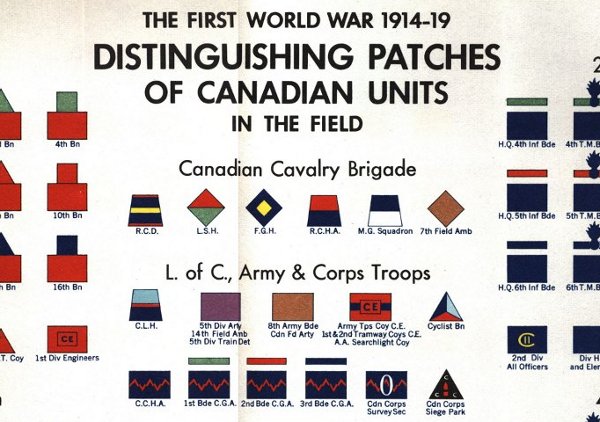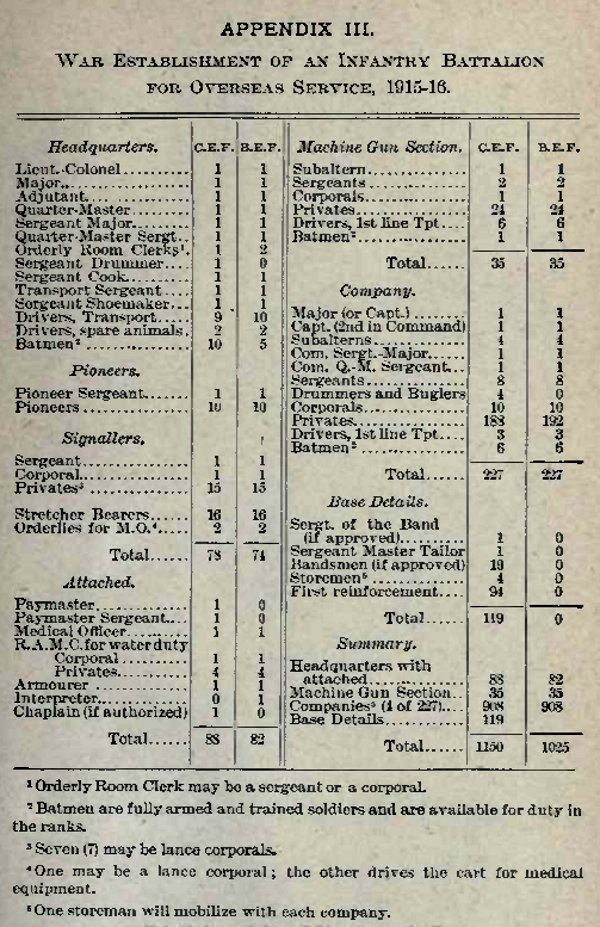
Researching Canadian Soldiers of the First World War
Part 17: Battalions and Brigades, Companies and Corps
By Michael O'Leary; The Regimental Rogue
Introduction
"A platoon is the smallest unit which comprises all the weapons with which the infantry soldier is armed–namely, rifle and bayonet, Lewis guns, rifle bomb, and bomb. It normally consists of four sections of one N.C.O. and five to nine other ranks, and a headquarters of one Officer and three other ranks. Exclusive of its Headquarters, therefore, its minimum strength is 24 and its maximum 40."
The Training and Employment of Platoons, 1918
To a new researcher the organization of an army, its units, and where a soldier they are researching fits in can be pretty much incomprehensible at first. The few leads that might be found in a soldier's letters, or in his service record, can be sparse clues to establishing a good understanding of where he fits in the wider picture of the Canadian Expeditionary Force. Even consulting with friends or relatives with recent military experience can confuse as much as help, because their knowledge will be specific to their own period of service and units, and may not provide detailed information on unit structures of the CEF unless they have studied those specifically.
This article will introduce, in general terms, the structure of more common units of the CEF. That will, admittedly, omit the particular circumstances of many Canadians who served overseas, but will form a starting point for the majority. While this article can offer that starting point, you should keep in mind that unit structures could change throughout the war, and because an element may not be found in an organizational chart at one time does not preclude its existence at an earlier or later point in the war.
As with other articles in this series, purists and experienced researchers may desire a more rigorous use of terminology in their own areas of specialization. To achieve this would make these articles more onerous for new researchers, with more emphasis being placed on details and minutiae than most will be seeking at this stage in their research. As you develop a better understanding of the specific areas of interest you are investigating, many individual experts can be found on the Canadian Expeditionary Force Study Group and the Great War Forum who will be delighted to help an interested researcher explore their own areas of more focused research.
The Big Picture
As you embark on your research into the activities of Canadians in the First World War, you will find a number of terms used to represent the encompassing organizations of Canadians overseas. These will include:
- The Canadian Expeditionary Force (CEF): In general, all Canadians sent overseas formed the CEF.
- Overseas Military Forces of Canada (O.M.F.C.): Established in December 1916 to oversee all of the activities of Canadians overseas in Europe, in particular with regard to the command and administration of the 7240 officers and 128,980 Canadian who were in the United Kingdom, separate from the front line units in France. While administration and national command aspects of personnel in France and Belgium would also be handled by O.M.F.C. Headquarters, tactical command would remain with the British field army. (The annotation of "O.M.F.C." will most often be seen in soldiers' service records when they are struck off the strength of the O.M.F.C. on being sent back to Canada.)
- The Canadian Corps: Used to describe the largest fighting formation of the Canadians in France and Belgium. As an army formation, a corps can consist of a number of divisions. The Canadian Corps, in the later years of the war, commanded the four Canadian Infantry Divisions as it's primary subordinate formations.
- Canadian Siberian Expeditionary Force (CSEF): A smaller Canadian expeditionary force that was sent to Siberia in 1919.
To the vast majority of Canadian soldiers overseas during the First World war, the passage of responsibility for their training and command as they joined the CEF, crossed the Atlantic to the OMFC and (for most) then crossed the Channel to join the Canadian Corps at the front would have been an invisible transition of their "ownership." Even in their service records, those transfers are not always clearly noted in those terms, nor will they deeply impact on the research of individual experiences of individual soldiers. Soldiers more readily identified with, and they can be more clearly followed in their records by, the unit the joined and, ultimately, the unit they served overseas with.
Units: Recruiting, Training and Reserve
Soldiers join units (some with an infantry or cavalry bias, will say "regiments", but the difference at this point is moot). Soldiers recruited into the Canadian Expeditionary Force in Canada joined their local units, choosing between the many battalions of infantry, regiments of cavalry, batteries of artillery, diverse service support units, and the many drafts of reinforcements that were raised across Canada throughout the War. Some units were recruited, trained and made it to the front under their original designations. But the majority were used as recruiting drafts, feeding the reinforcement stream that maintained the fighting strength of units of the Canadian Corps in France and Belgium. While some later units were re-designated and employed for purposes other than their original recruiting intent, most were dissolved into the Reserve unit system, forming new drafts of reinforcements for front line units as needed.
As noted in Part 10: Service Numbers, the many different units and drafts that recruited for the CEF can be seen in the list of assigned blocks of CEF Service Numbers (pdf, 1.9 Mb).

An excerpt from the CEF service numbers document showing the number blocks assigned to units.
( CEF Service Numbers (pdf, 1.9 Mb))
For most soldiers, the unit they were recruited into was the first unit they identified with, and for many it was the one known to their families because it was the "local unit" that their son/brother/father marched away to war with.
NOTE: In many cases, this "identification with unit" was an extension of familial identification with the local unit of the Canadian Militia, capitalized upon by canny recruiting methods that adopted unit titles, dress and badge designs from the Militia for CEF infantry battalions raised in the same localities. See below for more on connections between CEF and Militia units.
But for most soldiers of the CEF, whether in the infantry, the artillery, the medical corps or another trade, many did not serve at the "front" (whether for them it was a trench, a howitzer position, a hospital ward or an office) with the unit that recruited them. The CEF maintained a system of training and Reserve units that, itself, evolved continuously throughout the war. The scope of this article is too brief to explore the evolution of that system, and those seeking to identify the locations and dates of existence of specific training and reserve units will find assistance through the Canadian Expeditionary Force Study Group and the associated CEF Study Group Matrix.
Units: At the Front
Because of the preponderance of infantry in the CEF, many discussions of CEF units and organizations tend to use generalizations and terminology best suited to describing the experiences of infantry soldiers. As noted above, referring to the "front" for a given soldier may not mean the literal front line trench manned by riflemen, Lewis Gunners and bombers. For those many soldiers of the CEF who were not in the infantry, their "front" was their place of duty and whether that was an artillery battery, a hospital, or a light railway, they too contributed to the success of the CEF as much as any infantry soldier.
The principal units of the CEF that served in France and Belgium are listed in Annex B to the Official History of the Canadian Army in the First World War: Canadian Expeditionary Force 1914-1919. An excerpt of that Annex is shown below, with a link to display the full table.

An excerpt of the table in Annex B to the Official History of the Canadian Army in the First World War: Canadian Expeditionary Force 1914-1919.
(See the full Annex table in one image.)
A few relevant definitions from Organization, Administration and Equipment of His Majesty's Land Forces in Peace and War (1916):
Army Troops: Units which are not part of any division or army corps, but are directly under the command of the commander of an army. They may comprise signal units, air-service, bridging units, supply and ambulance units, cavalry or mounted rifles and one or more infantry battalions according to circumstances.
Corps Troops: Units which are not part of any division but are directly under the orders of the Commander of an Army Corps.
Divisional Troops: Units of a division which do not form part of the infantry brigades, but are directly under the orders of the divisional commander.
The following definition for "Formation" is provided in the Field Service Pocket Book (1926):
Formation: A number of fighting units grouped together under one commander may be referred to as a "formation." The lowest permanent formation is a cavalry or Infantry Brigade. Other permanent formations are:– (a)Division, (b) Corps, (c) Army.
Formations and Units
As seen in the table linked above, the structure of the CEF consisted of Army and Corps Troops (i.e., all units outside of the Divisions), and the four Canadian Infantry Divisions. The primary subordinate formations of each Division were the Infantry Brigades. As well it will be noted that the Brigade organization was employed in the Corps Troops for the Artillery. (Here also is where it can start to get confusing, with the use of the term "Corps" both as a tactical organization, and as a title for the collective of units of a particular nature, such as the "Machine Gun Corps" or "Medical Corps.")
For our purposes, the primary use of the term Corps is as in "Canadian Corps" referring to the highest level of combat formation fielded by the Canadians in the First World War. The Canadian Corps' subordinate formations were Divisions and Brigades.
While you won't find the term "formation" used much in the service records or other documents specific to researching an individual soldier of the CEF, it is helpful to understand the hierarchy of formations within which most soldiers were employed. These were, in decreasing order:
- Army
- Corps
- Division
- Brigade
- and, as noted, Brigades were formed of Units (e.g., Battalion (of Infantry), Battery (of Artillery), or Regiment (of Cavalry), etc.)
To carry this into a more practical example, let us presume the soldier we are researching fought in France with the 49th Canadian Infantry Battalion. Examining the "Composition of Division" section of the linked chart above shows us that his unit fell under the following organization:
- The Canadian Corps
- The 3rd Canadian Infantry Division
- The 7th Canadian Infantry Brigade
- and the 49th Battalion, which was the third battalion of the 7th Brigade.
Usually a researcher will confirm the unit a soldier served with from his service record. Occasionally, you may not even have a confirmed name to start with, but may have a photograph you are trying to match to one of several possible soldiers. Soldiers of the First World War, as they do today, wore distinctive unit patches that identified their units. The following image shows an extract of a chart of distinguishing patches worn by soldiers of the CEF, the link below the image will display the full chart. An alternative resource, which has an even larger presentation of CEF patches, is "Distinguishing Patches", by Clive M. Law (Second Edition, Service Publications, 2008).

Distinguishing Patches of the units of the Canadian Expeditionary Force. Source: Official History of the Canadian Army in the First World War: Canadian Expeditionary Force 1914-1919
(See the full chart in one image.)
Unit Establishments
The following sections will provide very brief overviews of the organization and manning of common units within the CEF. The primary reference used is the Field Service Pocket Book (1914) and the numbers given are for War Establishments (c. 1914) provided in that publication. As you follow the path of your soldier through his service in the War, keep in mind that battlefield casualties, reinforcement shortfalls and many other reasons may result in units going into battle with less manpower than the War Establishments indicate. More often than not, when units were undermanned, they were still tasked to perform on the field of battle as if they were at full strength.
The Cavalry
- Cavalry Regiment: 23 officers, 523 other ranks
- HQ and M.G. Sect: 8 officers, 67 other ranks
- Squadron: 6 officers, 152 other ranks
- Cavalry Squadrons are further divided into Troops and Sections
The Field Artillery
- 18-pounder Brigade (18 guns): 23 officers, 772 other ranks
- 18-pounder Battery (6 guns): 5 officers, 193 other ranks
- 18-pounder Ammunition Column: 3 officers, 155 other ranks
- 4.5-inch Brigade (18 guns): 22 officers, 733 other ranks
- 4.5-inch Battery (6 guns): 5 officers, 192 other ranks
- 4.5-inch Ammunition Column: 2 officers, 119 other ranks
The Infantry
- Infantry Battalion: 30 officers, 977 other ranks
- HQ and M.G. Sect: 6 officers, 93 other ranks
- Company (4): 6 officers, 221 other ranks
- Infantry Companies are further divided into Platoons (4) and Sections (4 per Platoon)
The infantry platoon, as described in The Training and Employment of Platoons, 1918:
"A platoon is the smallest unit which comprises all the weapons with which the infantry soldier is armed–namely, rifle and bayonet, Lewis guns, rifle bomb, and bomb. It normally consists of four sections of one N.C.O. and five to nine other ranks, and a headquarters of one Officer and three other ranks. Exclusive of its Headquarters, therefore, its minimum strength is 24 and its maximum 40."

This table, from Organization, Administration and Equipment of His Majesty's Land Forces in Peace and War (1916), presents and compares the authorized War Establishments for infantry battalions of the Canadian Expeditionary Force (CEF) and the British Expeditionary Force (BEF) for 1915.
Other examples of CEF unit organizations from the same reference are:
Cavalry Regiment
Divisional Signal Company
Pioneer Battalion
Field Ambulance
Machine Gun Company (early provisional organization)
Lineage: Connecting the CEF to the Canadian Militia and Permanent Force
When the Canadian Expeditionary Force was established to form Canada's contribution to the Empire's war effort in Europe, it was created as a separate organization from the existing Permanent Force (the Regular Force in today's parlance) and the Militia (today, the Reserves). Setting aside any political aspects on why this may have been done, it both created a new field army distinct from established influences, but also set the scene for confusing and over-lapping interests at the time and since.
Some newly created units drew upon the traditions, names, badges and influence of the potential recruit's sense of belonging to a "family regiment" in order to attract recruits. For example, the 13th Canadian Infantry Battalion, recruited in Montreal and the Pictou area of Nova Scotia, was named the "13th Battalion, Royal Highlanders of Canada", wore a badge identical to that of The Black Watch (Royal Highland Regiment of Canada) and adopted that Militia unit's traditions. But the 13th Battalion was not the Black Watch, nor was it a battalion of the Black Watch of the Canadian Militia.
Towards the end of the war, however, it was realized by the military establishment and by the Canadian government that at the end of the war the CEF would cease to exist on demobilization. If this occurred, all unit battle honours, and individual honours, would cease to be represented in the remaining Canadian military (except for those few units which would revert to the Permanent Force) because there was no formal organizational structure across which those battle honours and achievements could automatically transfer. After long years of fighting, it was felt necessary to now establish connections between the fighting units of the CEF and units of the Canadian Militia, so that those honours could be passed back to the Militia units and carried forth in history. Thus was born the "Otter Commission" and the very uniquely Canadian concept of perpetuation.
General William Dillon Otter, … was appointed to head a commission tasked to assign links between units of CEF and the units of the Canadian Militia. Establishment of perpetuation between specific units was based primarily on geographical connections to the recruiting areas of the CEF battalions. This concept of perpetuation provided a basis by which the achievements and battle honours of the CEF would be transferred to and carried forward by units of the Militia and the Permanent Force. If the Otter Commission had not been created and executed its work, much of the CEF and its achievements would have no official connection with existing units of the Canadian Army today. - Battle Honours of The Royal Canadian Regiment; 1915: The Beaches of Bermuda and the Battlefields of Belgium
Thanks to the work of the Otter Commission, there is today a formal link between the "13th Canadian Infantry Battalion" of the CEF and "The Black Watch (Royal Highland Regiment of Canada)," and similar links of perpetuation for many of today's Reserve and Regular Force units of Canada's Army to units of the CEF. The details of how that came to be, however, have easily been misplaced in the oral, and sometimes in the written, histories of many Canadian units today. While your research into a soldier of the CEF may take you to examine the regimental history of a perpetuating unit of the Canadian Army, that link which placed that CEF soldier's fighting unit within the history of an existing unit most likely came about only after the battles in France and Flanders were won.
Read further resources regarding the perpetuation of battle honours at The Regimental Rogue:
- Perpetuation of the Units of the Canadian Expeditionary Force (C.E.F.), 1914-1919
- Perpetuation and the Centenary of the Great War
- Battle Honours of the Royal Canadian Armoured Corps
- Battle Honours of the Royal Canadian Infantry Corps
Researching Canadian Soldiers of the First World War
- Introduction
- Part 1: Find your Man (or Woman)
- Part 2: The Service Record
- Part 3: Court Martial Records
- Part 4: War Diaries and Unit Histories
- Part 5: Casualties
- Part 6: Researching Honours and Awards
- Part 7: Deciphering Battlefield Location Information
- Part 8: More Mapping Information
- Part 9: Matching Battlefield Locations to the Modern Map
- Part 10: Service Numbers; More than meets the eye
- Part 11: Rank, no simple progression
- Part 12: Medals; Pip, Squeak, Wilfred and the whole gang
- Part 13: Evacuation to Hospital
- Part 14: The Wounded and Sick
- Part 15: Crime …
- Part 16: … and Punishment
- Part 17: Battalions and Brigades, Companies and Corps
- Part 18: Photo Forensics: Badges and Patches
- Part 19: Veterans Death Cards
- Part 20: The Vimy Pilgrims (1936)

- The O'Leary Collection; Medals of The Royal Canadian Regiment.
- Researching Canadian Soldiers of the First World War
- Researching The Royal Canadian Regiment
- The RCR in the First World War
- Badges of The RCR
- The Senior Subaltern
- The Minute Book
- Rogue Papers
- Tactical Primers
- The Regimental Library
- Battle Honours
- Perpetuation of the CEF
- A Miscellany
- Quotes
- The Frontenac Times
- Site Map
QUICK LINKS
- Tomb of the Unknown Soldier
- Vimy Memorial
- Dieppe Cemetery
- Perpetuation of CEF Units
- Researching Military Records
- Recommended Reading
- The Frontenac Times
- RCR Cap Badge (unique)
- Boer War Battles
- In Praise of Infantry
- Naval Toast of the Day
- Toasts in the Army (1956)
- Duties of the CSM and CQMS (1942)
- The "Man-in-the-Dark" Theory of Infantry Tactics and the "Expanding Torrent" System of Attack
- The Soldier's Pillar of Fire by Night; The Need for a Framework of Tactics (1921)
- Section Leading; A Guide for the Training of Non-Commissioned Officers as Commanders and Rifle Sections, 1928 (PDF)
- The Training of the Infantry Soldier (1929)
- Modern Infantry Discipline (1934)
- A Defence of Close-Order Drill (1934): A Reply To "Modern Infantry Discipline"
- Tactical Training in the British Army (1901)
- The Promotion and Examination of Army Officers (1903)
- Discipline and Personality (1925)
- The Necessity of Cultivating Brigade Spirit in Peace Time (1927)
- The Human Element In War (1927)
- The Human Element In Tanks (1927)
- Morale And Leadership (1929)
- The Sergeant-Major (1929)
- The Essence Of War (1930)
- Looks or Use? (1931)
- The Colours (1932)
- Personality in Leadership (1934)
- Origins of Some Military Terms (1935)
- Practical Examination; Promotion to Colonel N.P.A.M. (1936)
- Company Training (1937)
- Lament Of A Colonel's Lady (1938)
- Morale (1950)
- War Diaries—Good, Bad and Indifferent
- Catchwords – The Curse and the Cure (1953)
- Duelling in the Army
- Exercise DASH, A Jump Story (1954)
- The Man Who Wore Three Hats—DOUBLE ROLE
- Some Notes on Military Swords
- The Old Defence Quarterly (1960)
- Military History For All (1962)
- Notes for Visiting Generals (1963)
- Hints to General Staff Officers (1964)
- Notes for Young TEWTISTS (1966)
- THE P.B.I. (1970)
- Standing Orders for Army Brides (1973)
- The Time Safety Factor (1978)
- Raids (1933)
- Ludendorff on Clerking (1917)
- Pigeons in the Great War
- Canadian Officer Training Syllabus (1917)
- The Tragedy of the Last Bay (1927)
- The Trench Magazine (1928)
- Billets and Batman (1933)
- Some Notes on Shell Shock (1935)
- Wasted Time in Regimental Soldiering (1936)
- THE REGIMENT (1946)
- The Case for the Regimental System (1951)
- Regimental Tradition in the Infantry (1951)
- The Winter Clothing of British Troops in Canada, 1848-1849
- Notes On The Canadian Militia (1886)
- Re-Armament in the Dominions - Canada (1939)
- The Complete Kit of the Infantry Officer (1901)
- The Canadian Militia System (1901)
- The Infantry Militia Officer of To-day and His Problems (1926)
- Personality in Leadership (1934)
- British Regular Army in Canada
- Battle Honours (1957)
- Defence: The Great Canadian Fairy Tale (1972)
- The Pig (1986)
- Standing Orders for the Fortress of Halifax, N.S.; 1908
- Medals and Badges - Fakes and Copies
- Army Punishments Part 1 - • Part 2
• C.A.R.O. No. 6719 - Campaign Stars, Clasps, The Defence Medal and the War Medal 1939-45
[an error occurred while processing this directive]
[an error occurred while processing this directive]
[an error occurred while processing this directive]